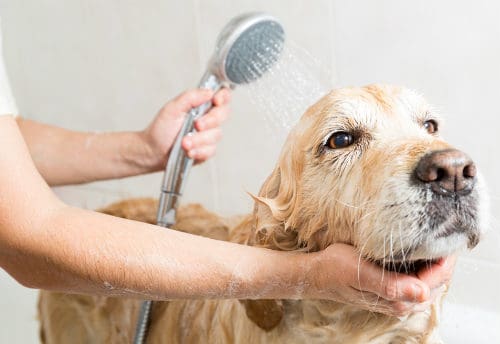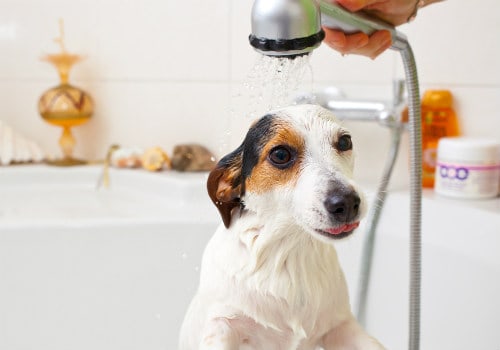Your dog is always down for fun, especially if it involves water. A romp in the snow, a splash in the pond or a swim in the pool is sure to make his day — and good luck getting him to come inside and dry off!
But a bath in the tub? Forget about it!
Once you turn that knob and call his name, he runs for cover like his life depends on it. Finally getting him into the bath can take forever, require multiple people or even necessitate picking him up and putting him in yourself.
Why are baths such a big deal to your dog? Are they that much different from the other forms of water that he loves so much?
Let’s look at baths from your dog’s perspective and see why he finds bath time so bothersome. And along the way, we’ll share some tips to resolve your dog’s grievances and make bath time more bearable for both of you!
Five Reasons Why Dogs Hate Baths

1. When You Stress Out, So Does Your Dog
Believe it or not, your dog’s hatred of bathtime may begin before you even walk into the bathroom. And it’s all to do with your anxious anticipation of getting him clean.
Think about how you feel in the moments before you bathe your dog.
Do your memories of past bathtime difficulties make you feel stressed out, worried or frustrated?
Does your body fill with dread at the prospect of struggling to get your dog into the tub again?
Are you tense to the point that you’re exhibiting nervous behaviors like sighing, pacing or fidgeting?
If so, your dog is probably mirroring your behaviors and feelings. He’s extremely perceptive and in tune with your moods, so if he detects that something’s making you anxious, he’ll feel anxious too.
And anxiety makes for an uncooperative dog.
Staying calm, taking deep breaths and thinking positive thoughts will go a long way towards lowering anxiety for both you and your dog. Talk to him in an excited, happy voice and try to give off good vibes — he’ll be a lot more likely to make it through bathtime without a fuss!
2. Baths Make Your Dog Feel Out of Control
When your dog splashes along the shoreline or paddles in the pool, he’s doing so entirely of his own volition. He can get in or out whenever he wants, and it’s totally up to him what he does with his time in the water.
But baths are a different story. He doesn’t get to decide when he takes them, how long they last, how hot they are or anything else about them — you’re in control during a bath, not him.
This loss of control doesn’t feel good for him. He’s used to being in the water on his own terms, so being at your mercy makes him feel trapped, vulnerable and just plain bad.
Now, if it were up to him, your dog would probably never take a bath, so giving him full control isn’t the answer. But you can make him feel a little more empowered during bathtime by being gentle and firm but not forceful during the process.
This means no pushing or pulling him into the bathroom and no strongarming him into remaining in the tub. We know it’s tough to bathe your dog without using some type of force, but keeping it to an absolute minimum will make him more compliant and comfortable with bathing.
3. Water Temperature and Pressure Can Hurt

Ever gotten into the shower without doing a temperature check only to scald yourself and leap back out? How about stepping in and finding out, quite painfully, that whoever used it before you turned the water pressure way up?
These occurrences are unpleasant enough when they happen once in a while, but to your dog, they may sum up bathtime perfectly.
Without the ability to control his own water temperature and pressure, your dog has to put up with whatever you set them to. But what’s comfortable for you may not be comfortable to him.
Water that’s too cold or too hot can cause your dog pain, as can powerful sprays from the showerhead. Turn down the water pressure and keep the water temperature close to room temperature to make your dog feel more comfortable.
And after the bath, dry him off thoroughly and wrap him in a warm, dry towel to keep him from getting too chilly. If he can tolerate the noise, you may wish to blow-dry him (on the lowest warm setting) to speed up the process.
4. Soaps Smell Weird — and Stink Smells Good
Your dog’s highly sensitive nose is hundreds of times more powerful than yours. As a result, he smells the world quite differently from you — in fact, many smells come across as complete opposites.
For instance, you may enjoy that floral-scented body wash or fruity shampoo, but to your dog, the smells of the chemical ingredients can be unpleasant or even offensive. On the other hand, his grimace-inducing BO is, to him, the world’s finest cologne — and it’s all-natural, too!
To your dog, taking a bath is akin to having a bag of garbage dumped on your head. Soap makes him smell unfamiliar and unnatural, and with such a powerful nose, that new scent is impossible to ignore.
The last thing you want to do is offend your dog’s sense of smell. So save the scented soaps for your bathtime and only bathe your dog with unscented shampoos that are formulated specifically for dogs.
5. Slippery Surfaces Are Hard to Stand On
A dog’s paws are built for rough ground — grass, dirt, rocks and other uneven terrain. His claws provide grip and his textured paw pads provide cushioning and a little extra friction to keep him stable.
Slippery surfaces, like bathroom tile and the floor of your tub, simply don’t feel right to him. There’s nothing to grip and no give to the material, so he can feel unstable and off-balance..
And if his nails are long, it can physically hurt him if they contact a hard surface with a lot of pressure.
If your tub is smooth, try placing a textured tub mat in it to give your dog a padded, grippable surface to stand on. And layout towels or bath rugs for him to walk on if he seems uncomfortable walking on the cold tiled floor.
